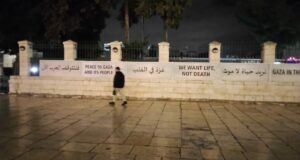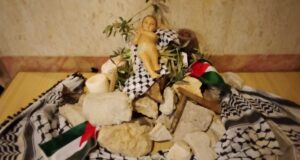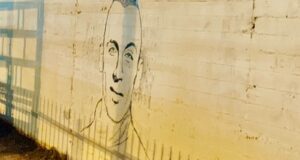In the space of two weeks, the Israeli occupying army has come to the village of Walaja at least three times. The first time was to demolish an outbuilding that housed animal feed. The second, last week, was to arrest a father of five during the night for apparent links to political party Hamas (he works for a Bethlehem orphanage supported by the social services part of Hamas). The third was this morning when they came to demolish the home of Monder Abed Hamad and his family, for the second time.
The family have the misfortune to live in the Ein Jwzeh neighbourhood of Walaja, part of the village that was unilaterally taken into the borders of Israel after the 1967 war. About one year ago their home was demolished as it did not have an Israel building permit, the fact that it had a Palestinian permit makes no difference- this part of the village is now deemed to be “Israel”. 20 other homes have so far been demolished for the same reason, and a further 50 have demolition orders on them. As the family own this piece of land, and could not afford the Israeli permits even if the courts would grant them one (which is highly unlikely) they rebuilt their home with help from the rest of the village. The rebuild was completed around 5 months ago, today, in around two hours the home was again reduced to rubble and a pile of belongings. Today the family will move into rented accommodation, whether they will once again try to rebuild their home is unsure: their land lies along the route of the Israeli apartheid (security) wall that is set to completely surround the village.
None of this is new for Walaja just the latest chapter in a long story of injustice, as one of the residents of Walaja commented “…it’s always the same picture for us”. All of the inhabitants of this village are classed as refugees: they were forced from their homes after the 1949 ceasefire between Israel and Jordan. Unfortunately under this agreement, the village of Al Walaja lay in the area under Israeli control and they were “encouraged” to leave. All of the inhabitants left their homes and the village moved just a few hundred metres south, still on Al Walaja land, into the area now known as “the West Bank”. The Israeli colony of Aminadav and a park was built over the original village. Not all of the villagers were able to rebuild their homes at this time, many moved into the refugee camps that surround Bethlehem, or over the river into Jordan. Those that were able to rebuild their homes and lives did so on the slopes south of the original village.
After the 1967 war Israel expanded its borders, taking more Palestinian land and Al Walaja fell back into the area controlled by the Israelis, an area now known as “Greater Jerusalem”. This doesn’t mean that the villagers got any of the perks of being an Israeli citizen like the ID cards that allow them to travel around their own country relatively easily. What it does mean is that one third of the new village’s land was taken and the Gilo colony built there, in the rest of the village 70 houses have demolition orders on them, 20 so far have been destroyed- they had Palestinian building permits, not Israeli ones. It also means that the village is now surrounded by the Israeli colonies that are cutting the city of Jerusalem off from the rest of the West Bank (i.e. making Jerusalem an entirely Israeli city). As such, they have lost much of their land, and are destined to lose much more. It also means that as the villagers are now living in “Israeli Greater Jerusalem” but have Palestinian ID cards, they are subject to frequent harassment and arrest by the Israeli army.
As Walaja is surrounded by Israeli colonies the so called “security-wall” is set to completely surround the village, cutting it off from Bethlehem and confiscating yet more of the village land. The land lost by Walaja and neighbouring Battir village will be used to build the colony of Giv’at Ya’il. This huge colony will house around 50,000 Israelis and will link the colonies deep in Palestinian territories with those immediately outside of Jerusalem. Could it be a coincidence that this land confiscation has allowed the separation of strategically and spiritually important Jerusalem from Palestine?
So what does the future hold for Walaja? When the wall is finished the villagers will have to pass through an Israeli controlled gate to get in or out of the village. To get into the city of Bethlehem where many of the villagers work, attend school or university and buy supplies, the villagers will have to pass through two checkpoints. The route of the wall passes through many economically important olive groves, already three hundred trees have been destroyed. This in itself is an infuriating story. The villagers had gone to court to try and prevent the destruction of their trees. The Israeli court had ruled in their favour, saying that the trees could not be “up-rooted”. In an act of barbarism and disrespect that typifies the army’s response to the rare court orders granted in favour of Palestinians, they came with chainsaws and cut down the trees instead of digging them up, thus complying with the order to not up-root the trees.
And so life here goes on…as the democratic state of Israel, whilst demanding that groups like Hamas agree to its right to exist, quietly makes life for Palestinians in what little they have left of their country, unbearable and next to impossible.
 International Solidarity Movement Nonviolence. Justice. Freedom.
International Solidarity Movement Nonviolence. Justice. Freedom.


